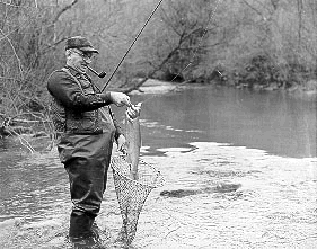
Doe Creek Rainbow Trout Spawning Run
UPDATED OCTOBER 2006
Doe Creek Rainbow Trout Spawning Run
Doe Creek is a spring-fed stream that flows around Doe Mountain in Johnson County before entering Watauga Lake. It currently supports an exceptional wild rainbow trout population and has produced some of the highest abundance estimates and largest fish sampled in Tennessee streams in recent years. However, Doe Creek is probably best known for its trophy rainbow trout fishery in the 1950s and 1960s. This fishery was provided by a distinct stock of rainbows that originated from eggs planted by TWRA at the mouth of Doe Creek in 1954. They resided in Watauga Lake and ascended Doe Creek in the fall and winter to spawn at about three years of age and an average size of 18" and 2.7 lbs. Anglers came to Doe Creek from across the eastern U.S. and at one time, a Doe Creek fish held the state record for rainbow trout (almost 13 lbs.). Unfortunately, the spawning runs eventually declined and attempts to improve them, including construction of a spawning channel that is still visible along Hwy. 67 near Pandora, were unsuccessful. The fishery disappeared in the early 1970s.
In early March 2001, efforts to re-establish a population of rainbow trout that would live and grow in Watauga Lake and use Doe Creek to spawn were renewed. The Overmountain Chapter of Trout Unlimited (TU) in Johnson City funded the purchase of 25,000 eyed Kamloops rainbow trout eggs from a hatchery in Washington State. This is a lake-dwelling strain of rainbow trout that ascends tributary streams to spawn. Members of the Overmountain TU Chapter and TWRA planted half of the eggs in the lower portion of Doe Creek. The remaining eggs were hatched at TWRA's Buffalo Springs facility and will be stocked in lower Doe Creek as fingerlings. This process will be repeated for the next two years if fish are available and hopefully, some of these rainbows will instinctively return to spawn in about 2004. If unsuccessful, other strains of rainbow trout with the appropriate characteristics may be tried, including the large fish that currently enter Clear Creek from the Clinch River (Norris tailwater) each winter.